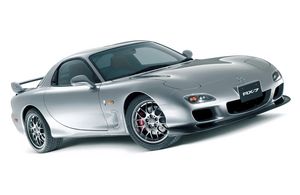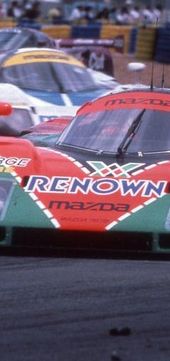.
Mazda RX-7: Difference between revisions
24.9.207.129 (talk | contribs) |
24.9.207.129 (talk | contribs) (→Awards) |
||
| Line 272: | Line 272: | ||
==Awards== | ==Awards== | ||
IMSA/GTU champion 82-84 | |||
==See also== | ==See also== | ||
Revision as of 13:56, 26 May 2008

| |
| Mazda RX-7 | |
|---|---|
| Mazda | |
| aka | |
| Production | 1979-2002 |
| Class | Sports Car |
| Body Style | Two Door Coupe |
| Length | |
| Width | |
| Height | |
| Wheelbase | |
| Weight | 3200-3400 lbs |
| Transmission | four speed automatic or 6 speed manual |
| Engine | 1.3 liter naturally aspirated or turbocharged rotary |
| Power | 135-255 HP |
| Similar | Toyota Supra Turbo, Mitsubishi 3000GT, Nissan Skyline |
| Designer | |
The Mazda RX-7 was a japanese vehicle manufactured from 1979-2002. The vehicle was unique in that during its production, it was the only rotary engined car available. The vehicle has been very popular with import car tuners, as well as well as some autocross drivers.
See Wikicars' comprehensive <MODEL> Review.
Recent Changes
- In 2002, special edition model with special white pearl paint and black painted wheels was introduced. Engine- 1.3L rotary, transmission- 5 speed, 6 speed manual, 4 speed automatic.
Styles and Major Options
Certain vehicles come in different trim levels or body styles. Features and major options should be mentioned here.
Pricing
Add more fields as necessary.
|
MODEL Trims |
|||
|
Trim1 |
Trim2 |
Trim3 |
Trim4 |
|
MSRP |
|||
|
$Price1 |
$Price2 |
$Price3 |
$Price4 |
|
Invoice |
|||
|
$Price1 |
$Price2 |
$Price3 |
$Price4 |
Gas Mileage
Add more fields as necessary.
As seen on the FuelEconomy.gov website, the City/Highway MPG averages are as follows:
|
Trim |
|||
|
Trim1 |
Trim2 |
Trim3 |
Trim4 |
|
MPG |
|||
|
c/h |
c/h |
c/h |
c/h |
Reliability
Although there have been many complaints of overheating and premature engine wear, most well maintained examples can be reliable with over 150,000 miles. See Carsurvey.org for more reliability information and reviews
Safety
This section should reference points on safety ratings and features of the vehicle.
Photos
Add Photos of the vehicle here.
Please make sure not to use copyrighted photos.
Colors
List the colors that the particular <MODEL> is offered in.
Main Competitors
toyota supra, nissan z cars,(for late models)honda nsx
Hybrid Models
currently there isnt a hybrid rx7, but hopes are high with toyota returning the supra to the road as a hybrid. However there are hydrogen rotaries available from various performance shops. And also conversion kits. Some places to look include rotary response, RX7.com, mazdatrix, rotary shack, racing beat
Unique Attributes
The RX-7 uses the rotary engine comprised of 2 main rotors and an eccentric shaft, which acts like the crankshaft of a normal piston engine. Unique to rotary engines, each rotor is a traingle, which rotates around the oval shaped crankcase. Each rotor makes intake, combustion, and exhaust stroke all at nearly the same time. All rotary engines have a leading and trailing spark plug to help combustion thruogh the long cumbustion chamber. Due the the exremely compact size of these engines all rx7s have 50/50 weight distribution making handling phenomenal. These engines produce more power per pound than any other gas or hydrogen engine.
Resale Values
Add more fields as necessary.
|
<MODEL> Year |
|||
|
Year X |
Year X-2 |
Year X-3 |
Year X-4 |
|
Resale Value |
|||
|
$ |
$ |
$ |
$ |
Criticisms
Please make sure to keep critiques in a third-person point of view. If using criticisms from a reputable automotive source, then please make sure to cite the quote.
Generations
Fill in as many as appropriate. Add more if necessary and pictures wherever applicable.
Please make sure NOT to use copyrighted pictures.
Third generation (1993–1997)
The final us production of the rx7 came in 1997. The third gen was redesigned yet again. This time smaller than the second gen. The styling became very round and sleek. The viper would look similar. The third gens were offered with the standard, but revamped 165hp wankel 13b, or a twin turbo version pushing the engine easily over 200hp. The 90s technology boom also brought more advances to the engines sealing capability and life expectancy. These third gen motors got lighter rotors allowing faster accel and higher rpm. The cooling also got much better. The third gen motor is capable of 900+ horsepower, making this probably the most capable car ever build. In 96 the rx7 lost the pop up headlamps in favor of a more wicked looking set in headlight.
Second generation (1986–1991)
The second generation, grew heavier, retaining it's signature fantastic handling by adding a fully-independent rear suspension. The rear-end was controversial, but an engineering masterpiece. In order to make a 2+2 option available, trailing-arm was chosen over a double-wishbone. To avoid the problems typical of trailing arms (tail squat during acceleration, tail dive during braking) Mazda devised the Dynamic Tracking Suspension System utilizing floating "triaxial" hubs, which induced passive-steering (slight quicker "turn-in" of rear wheels at low speeds and better control during acceleration, braking and high-speeds). This passive-rear steer was popular in the late 80's (see 1988 Honda CRX Si) and was quickly followed by active-rear steering in subsequent Honda and Nissan cars until the present).
Styling of the 2nd gen was smooth, retaining pop-up headlamps with "flash-to-pass" lenses. A 2+2 option was finally available in the US and soon after introduction of the base (14-inch, four-lug wheels), Sport (15-inch alloys, firmer suspension) Luxury (14-inch alloys, sunroof) and GXL (15-inch alloys, adjustable CPU-controlled suspension, power windows, cruise), the 180hp, 183ft/lbs of torque "Turbo II" hit the streets. (The "Turbo I" was only available in Japan, the Turbo II in all markets.) A convertible model, with signature BBS wheels was introduced in 1988. In 1989 a "minor change" included round tail-lights and improvements to the 13b bringing power up on normally aspirated models from 146hp and 138ft/lbs of torque to 160hp and 140ftlbs of torque. The Sport became the GTUs the Luxury model was eliminated, but the GXL carried on with leather and 2+2 options. The Turbo now made 200hp and 196ft/lbs of torque and was shod with a 16-inch version of the ultra-light BBS of the convertible. In 1991 the line was simplified to the coupe, convertible and turbo. No RX-7's were manufactured in 1992, dealers selling off their stock of the 2nd gen until the more hard core and expensive 3rd gen finally replaced it.
First Generation/Origins (1979–1985)
The first generation rx7 was a light weight sport coupe. First offered with the all new 12a. The 12a was considerably improved over the firsth 10a rotaries. It featured a 4bbl niki carbueretor and 3mm apex seals. The 12a was significantly more powerful than the 10a at 101hp @ 6000rpm and 107ftlb@ 4000rpm. The new 12a would also make better emissions and cold starts. In 80 the rx7 began using a catalytic converter and a new capacitive discharge ignition system, making the car more reliable. In 84 two new versions of the rotary became available. In japan the 12a turbo model producing 165hp and a huge 160ftlb. And for the US an all new 6 port, fuel injected 13b, only offered in the gsl-se. Increased to 1.3 liters the new fuel injected engine would make 135hp@ 6000rpm and 133ftlb@ 2750rpm (jimrothe.com/mazdabrochures).
The Rx7 was offered in a few pakages GS, GSL, GSL-se. Optional on first gens was power steering, a/c, cruise, graphic eq, am fm cassette, sunroof, wider wheels, different ring and pinnion sizes and auto transmission. The gsl package came with 9 inch discs on the rear, while the se came with slotted 10 inch discs. The se also got a beefier suspension, clutch and axles, and a luxery interior.
Rx7s all began with a watt 4 link rear suspension. This left room to allow a 2+2 seating option as well. Overall weight of the car is around 2325 for a gs and 2575 for the gsl-se. All information in this first gen segment is cited directly from a mazda factory brochure. Have a look at jimrothe.com
Worldwide
Rx7 was available in japan, australia and uk
Design quirks and oddities
Mazda has made rotary pick ups as well.
Awards
IMSA/GTU champion 82-84
See also
External Links
Please include any external sites that were used in collaborating this data, including manufacturer sites, in this section.


